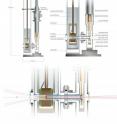RAMBO a small but powerful magnet
Related images
(click to enlarge)
Rice University scientists have pioneered a tabletop magnetic pulse generator that does the work of a room-sized machine -- and more. The device dubbed "RAMBO" -- short for Rice Advanced Magnet with Broadband Optics -- will allow researchers who visit the university to run spectroscopy-based experiments on materials in pulsed magnetic fields of up to 30 tesla. (A high-resolution magnetic resonance imaging system is about 10 tesla in strength.)
The Rice lab of physicist Junichiro Kono created RAMBO in collaboration with Hiroyuki Nojiri at the Institute for Materials Research at Tohoku University in Sendai, Japan. Details appeared online recently in the American Institute of Physics journal Review of Scientific Instruments.
The advantages of such a small machine are many, said Timothy Noe, a postdoctoral research associate in Kono's group and lead author of the paper. Aside from its size and powerful performance, RAMBO has windows that allow researchers to directly send a laser beam to the sample and collect data at close range.
"We can literally see the sample inside the magnet," Kono said. "We have direct optical access, whereas if you go to a national high magnetic field facility, you have a monster magnet, and you can only access the sample through a very long optical fiber. You cannot do any nonlinear or ultrafast optical spectroscopy.
"RAMBO finally gives us the ability to combine ultrastrong magnetic fields and very short and intense optical pulses. It's a combination of two extreme conditions."
The device's unique configuration allows for the best access ever in a powerful magnetic field generator meant for scientific experimentation. Researchers can collect real-time, high-resolution data in a system that couples high magnetic fields and low temperatures with direct optical access to the magnet's core, Kono said.
In addition, the unit can run a new experiment in a 30-tesla field every 10 minutes (or less for smaller peak fields), as opposed to waiting the hours often required for field generators to cool down after each experiment at large laboratories.
The device has already paid dividends for Kono's group, which studies superfluorescence by hitting materials with femtosecond laser pulses to trigger quantum effects. RAMBO allows the laser pulse, the magnetic field pulse and the spectrometer to work in sync.
RAMBO is possible, he said, because of Nojiri's development of a small and light mini-coil magnet. A little bigger than a spool of thread, the magnet allows Rice researchers to perform on campus many of the experiments they once carried out at the National High Magnetic Field Laboratory at Florida State University or at Los Alamos National Laboratory.
The Florida State facility has produced continuous magnetic fields of 45 tesla; Los Alamos has produced pulses over 100 tesla.
"I would say we've been able to do 80 percent of the experiments here that we used to have to do elsewhere," Kono said. "And that's not all. There are things that only we can do here. This is a unique system that doesn't exist anywhere else in the world.
"High magnetic fields have been around for many years. Ultrafast spectroscopy has been around for many years. But this is the first combination of the two," he said.
Kono's group built the system to analyze very small, if not microscopic, samples. A sample plate sits on a long sapphire cylinder that passes through the coil's container and juts through one end of the magnet to place it directly in the center of the magnetic field.
The cylinder provides one direct window to the experiment; a port on the other side of the container looks directly down upon the sample. The coil is bathed in liquid nitrogen to keep it cool at around 80 kelvins (-315 degrees Fahrenheit). The sample temperature can be independently controlled from about 10 K to room temperature by adjusting the flow of liquid helium to the sapphire cylinder.
Kono said he expects RAMBO to make Rice one center of an international network of researchers working on modern materials. "This opens up all kinds of possibilities," he said. "Scientists working in different areas will come up with new ideas just by knowing such a thing is possible."
He said the team has already collaborated with Jean Léotin, a co-author of the paper and a professor at the Laboratoire National des Champs Magnétiques Intenses in Toulouse, France, to perform one of the first time-domain terahertz spectroscopy experiments in high magnetic fields.
Co-authors include Joseph Lee, a student at Clements High School, Sugar Land, Texas, who works in Kono's lab, and Gary Woods, a professor in the practice of computer technology and electrical and computer engineering.
The National Science Foundation, the Department of Energy and the Robert A. Welch Foundation supported the research.
Source: Rice University
Other sources
- RAMBO a small but powerful magnet: System allows high-magnetic-field experiments on a tabletopfrom Science DailyMon, 6 Jan 2014, 22:00:42 UTC
- RAMBO allows high-magnetic-field experiments on a tabletopfrom PhysorgMon, 6 Jan 2014, 21:30:33 UTC


